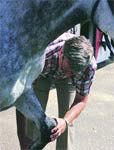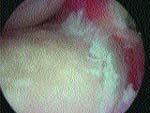Effectively diagnosing, treating equine degenerative joint disease
Dr. C. W. McIlwraith provides an overview on identifying and treating degenerative joint disease in horses.
Degenerative joint disease (DJD), also commonly referred to as osteoarthritis (OA), may be considered a group of disorders characterized by a common end stage, progressive deterioration of the articular cartilage, accompanied by changes in the bone and soft tissues of the joint. Synovitis and joint effusion are often associated with the disease. Clinically, the disease is characterized by pain and dysfunction of the affected joint. Human DJD has been classified conventionally into primary and secondary varieties. The term "primary" is used when the causes are unidentified and is typified by the insidiously developing disease of old people. The term "secondary" is used when an etiologic factor can be demonstrated. The term degenerative joint disease (DJD) has been used as a synonym for primary OA. However as more etiologic factors become identified, the distinction between primary and secondary lessens and osteoarthritis is more commonly used than DJD.

Photo 1: Diagnosis is an important component of managing osteoarthritis in the horse. A thorough examination of the horse is the first step to a meaningful diagnosis, and treatment, if necessary.
DJD manifestations
OA or DJD has a number of entities.
1. Acute is associated with synovitis and high motion joints and typically affecting the athlete on the high motion joints such as the carpal metacarpophalangeal joint.
2. Insidious involves the high load/low motion joints such as the interphalangeal and intertarsal joints. This type was initially classified as a disease that predominates in mature and aged horses, but is also a major problem in young, competitive horses and overlaps considerably with the acute category.
3. Incidental (non-progressive) articular cartilage erosion is recognized at arthroscopy or during necropsy and is of questionable significance.
4. Secondary to other identified problems such as intra-articular fractures, ligamentous tears and dislocations, wounds, septic arthritis and OCD. If the latter conditions are not treated effectively, secondary OA develops and leads to functional limitations.
Understanding the disease
The most common scenario facing the equine clinician is the DJD entity associated with synovitis, that, if treated ineffectively, leads to progressive degeneration of the articular cartilage. The pathobiologic pathways have been identified over recent years and are depicted in Figure 1, p. 6. Much of the early suggestions on pathogenesis and factors involved came from mediators identified in other species. However, all the mediators depicted have been identified as elevated and involved in equine joint disease. Most of the final definitive degradation comes from the action of neutral metalloproteinases and aggrecanase. Proteoglycans and their component glycosaminoglycans are degraded early in the osteoarthritic process. While stromeolysin (MMP3) was considered the main agent responsible, more recently it appears that aggrecanase causes most of the proteoglycan degradation in OA. Degradation of collagen results in the physical lesions we recognize histologically, arthroscopically and later, grossly. Most of the collagen degradation is effected by neutral metalloproteinases 1 and 13 (collagenase 1 and 3). The neutral proteinases can be produced by inflamed synoviocytes directly, but also by both synoviocytes and chondrocytes in response to stimulation from interleukin-1. IL-1 can be considered at the top of the osteoarthritic cascade. Low quantities are present in normal joints to allow for regular turnover of components, but in the osteoarthritic process, their levels are elevated. By stimulating cell surface receptors, IL-1 upregulates the production of neutral metalloproteinases, aggrecanase as well as prostaglandin E2 (PGE2). PGE2 is released from cells on stimulation by IL-1, but also can be produced directly. PGE2 not only increases pain sensitivity, but also can promote the degradation of proteoglycans and collagen as well as inhibit proteoglycan synthesis. Free radicals are also present in increased amounts in inflamed equine joints and seem to be the way the hyaluronin (HA) gets degraded in the joint fluid. Effective inhibition of these mediators is key to effective treatment of inflammatory joint disease in the horse and prevention of the osteoarthritic process.

Photo 2: Arthroscopic examination is considered a gold standard for evaluating early articular disease.
Diagnosis
Diagnosis is a key part of the management of OA. Clinical examination is still critical with lameness being localized to a particular joint or joints, synovial effusion in the acute stage and capsular fibrosis developing in the more chronic stage (Photo 1, p. 4). Radiographs are important to eliminate the presence of fractures and other bony problems, but are very limited in identifying the early osteoarthritic process. A number of advances have been made in recent years with diagnosis. Nuclear imaging can localize a process to an area or joint and is quite sensitive. However, it has poor specificity. Computed tomography (CT) is very useful for showing early subchondral bone change (microdamage in the subchondral bone is an early component of the osteoarthritic process and contributes to disease in the athlete). The usefulness of MRI in diagnosing early joint disease in the phalanges has been documented recently and the equipment is becoming available whereby more proximal joints can be imaged. This will provide a significant improvement in our ability to diagnose early disease in the articular cartilage, subchondral bone, menisci ligaments and joint capsule. Until that is achieved, arthroscopic examination is still the gold standard for evaluating early articular disease (Photo 2). Synovial fluid analysis has always been useful in defining the amount of inflammation in the joint. More recently, the development of biomarkers that can detect early degradation in proteoglycans and collagen has improved our ability to diagnose early articular disease. The accuracy for defining early osteoarthritis with biomarkers is now up to 90 percent, based on recent studies done at Colorado State University.
Treatment options
There are a number of treatment options in treating OA or DJD. Non-steroidal anti-inflammatory drugs (NSAIDs) have been commonly used. Phenylbutazone would be the most frequently administered. Prolonged use or high dosages have side effects, particularly to the GI tract and kidneys. In humans there is increased use of specific COX-2 inhibitors. Recent experience by the author with carprofen (Rimadyl®) in the horse is exciting (used in patients exhibiting signs of GI disturbance or nephrotoxcitiy have done well on Rimadyl using the product licensed for the dog).

Figure 1: Factors involved in the enzymatic degradation of articular cartilage matrix in equine OA. IL-1= interleukin 1; TNF-alpha= tumor necrosis factor alpha; FGF= fibroblast growth factor; PGE= prostaglandin; PLA-2= phospholipase A2; uPA= urikinease plasminogen activated; tPA= tissue plasminogen activator; PA= plasminogen activator; PGE2= prostaglandin E2; TIMP= tissue inhibitor of metalloproteinases.
The use of intra-articular hyaluronin or hyaluronic acid (HA) has been made for synovitis or OA in the horse since 1975. More recently two products have been licensed for use in human OA. Clinical experience in the horse is that HA is very useful for mild to moderate levels of synovitis, but has limitations with severe synovitis or when there is significant osteoarthritis present. However, used in combination with corticosteroids, considerable benefit can be obtained and there is clinical evidence that HA can placate the side effects of certain corticosteroids. In the past 10 years, use of intravenous HA has become common. There is only one licensed product made by Bayer (Legend® in the United States, Hyonate® elsewhere). In our experimental OA mode, use of 40 mg of Legend IV has been shown to be very effective in providing prolonged anti-inflammatory activity. It has also been used considerably on a "prophylactic" basis in the athlete. While there is anecdotal evidence of value, it has not been able to be demonstrated in controlled studies yet.
Intra-articular corticosteroids are still a major part of the armamentarium of equine clinicians working with the equine athlete. Benefits versus deleterious effects have become clarified in the past 10 years with controlled studies in an experimental OA model at CSU. Betamethasone esters (Betavet®, Schering) when the study was done, was shown to have no side effects on the articular cartilage, while promoting significant anti-inflammatory activity. Unfortunately, that product has become unavailable, as has the human product Celestone®. Clinicians have had to resort to compounding and good product is available through these channels. Triamcinolone acetonide (Vetalog®) not only has no negative side effects when evaluated in the model of OA, but joints treated with triamcinolone acetonide had articular cartilage in better condition than in the control placebo groups. Clinicians are concerned about the potential for laminitis with the use of this product, but it has been used very frequently without side effects as long as the total body dosage remains relatively low. On the other hand, work in the CSU model with methylprednisolone acetate (Depo-medrol®) has confirmed other work demonstrating that this medication will contribute to pathologic deterioration in the articular cartilage. Its use has become less frequent, but it is still used commonly because of its length of action as well as the relative lack of availability of other licensed products. It is important to try and minimize repeated use of this medication in joints other than the distal tarsal joints.
The only licensed glycosaminoglycan product is Adequan®. The subject of relative values of glycosaminoglycan products (including the oral ones) is addressed in the article on p. 8. The author has always considered PSGAG as the gold standard of a chondroprotective drug in the horse. It has been shown to inhibit the osteoarthritic process. It is commonly used after surgery when there is significant cartilage loss, exposure of subchondral bone and minimizes the progression of the osteoarthritic process in these cases. A recent development is the testing of pentosan polysulfate, which should be available relatively soon and will offer another systemic option.
Oral nutraceuticals is an area of great controversy. There is certainly good in vitro evidence in the horse for the beneficial effects of glucosamine and chondrosulfate in inhibiting the osteoarthritic process. There have also been other experiments showing absorption of these products, but none demonstrated efficacy in inhibiting the osteoarthritic process in vivo in the horse. A recent meta-analysis of the use of these products in humans for the treatment of knee osteoarthritis provides food for thought. According to a recent article in the Journal of the American Medical Association on meta-analysis, studies in the knee generally are of low to mediocre quality, are sponsored largely by manufacturers and show strong evidence of publication bias. It was found that positive responders in the treatment groups were enthusiastic about glucosamine about a treatment and had negative attitudes towards conventional medical treatments for knee OA. Responders in both groups had modest criteria for treatment efficacy. They expected modest relief of pain and only moderate improvement in ability. Responders were more likely to have had positive experience with compliment therapies in the past.

Suggested Reading.
The recent trend has been for the development of specific biologic therapies. The use of metalloproteinases inhibitors was the initial biological therapy evaluated, but results have been disappointing. Specific therapy aimed at inhibiting cytokines shows promise. TNF alpha is a cytokine important in rheumatoid arthritis in humans and there are licensed inhibitors now available. TNF alpha does not seem so important in equine OA, but IL-1 is and work in our laboratory showed excellent results providing the gene for IL-1 receptor antagonist using a viral vector. The gene therapy protocol showed significant inhibition of the osteoarthritic process in the horse.
Podcast CE: A Surgeon’s Perspective on Current Trends for the Management of Osteoarthritis, Part 1
May 17th 2024David L. Dycus, DVM, MS, CCRP, DACVS joins Adam Christman, DVM, MBA, to discuss a proactive approach to the diagnosis of osteoarthritis and the best tools for general practice.
Listen